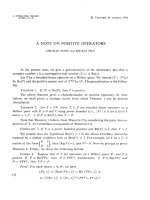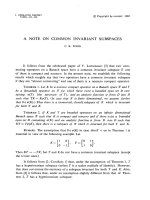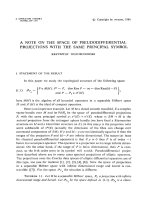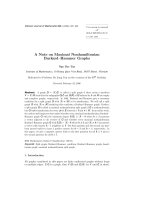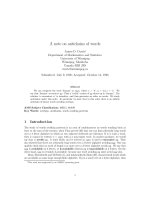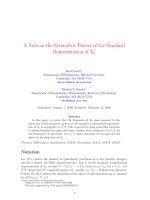Báo cáo toán học: "A note on neighbour-distinguishing regular graphs total-weightin" pdf
Bạn đang xem bản rút gọn của tài liệu. Xem và tải ngay bản đầy đủ của tài liệu tại đây (91.69 KB, 5 trang )
A note on neighbour-distinguishing regular graphs
total-weighting
Jakub Przybylo
AGH University of Science and Technology
Al. Mickiewicza 30, 30-059 Krak´ow, Poland
Submitted: May 22, 2007; Accepted: Sep 4, 2008; Published: Sep 15, 2008
Mathematics Subject Classifications: 05C78
Abstract
We investigate the following modification of a problem posed by Karo´nski,
Luczak and Thomason [J. Combin. Theory, Ser. B 91 (2004) 151-157]. Let us
assign positive integers to the edges and vertices of a simple graph G. As a result
we obtain a vertex-colouring of G by sums of weights assigned to the vertex and its
adjacent edges. Can we obtain a proper colouring using only weights 1 and 2 for an
arbitrary G?
We know that the answer is yes if G is a 3-colourable, complete or 4-regular
graph. Moreover, it is enough to use weights from 1 to 11, as well as from 1 to
χ(G)
2
+ 1, for an arbitrary graph G. Here we show that weights from 1 to 7 are
enough for all regular graphs.
Keywords: neighbour-distinguishing total-weighting, regular graph
1 Introduction
A k-total-weighting of a simple graph G is an assignment of an integer weight, w(e), w(v) ∈
{1, . . . , k} to each edge e and each vertex v of G. A k-total-weighting is neighbour-
distinguishing (or vertex colouring, see [1, 2]) if for every edge uv, w(u) +
eu
w(e) =
w(v) +
ev
w(e). If such a weighting exists, we say that G permits a neighbour-
distinguishing k-total-weighting.
A similar parameter, but in the case of an edge (not total) weighting, was introduced
and studied in [3] by Karo´nski, Luczak and Thomason. They asked if each simple con-
nected graph that is not simply a single edge permits a neighbour-distinguishing 3-edge-
weighting, and showed that this statement holds for 3-colourable graphs. Then Addario-
Berry, Dalal and Reed showed that it is enough to use numbers from 1 to 16 to construct
the electronic journal of combinatorics 15 (2008), #N35 1
a neighbour-distinguishing edge-weighting for an arbitrary graph (not containing a single
edge as a component), see [2].
In [4] we conjectured that numbers 1 and 2 in turn are enough to distinguish neighbours
of each graph by a total-weighting. We verified this conjecture for some classes of graphs
and established the following upper bounds.
Theorem 1 ([4]) All complete, 3-colourable and 4-regular graphs permit neighbour-dis-
tinguishing 2-total-weightings.
Theorem 2 ([4]) Each simple graph permits a neighbour-distinguishing 11-total-weigh-
ting and a neighbour-distinguishing (
χ(G)
2
+ 1)-total-weighting.
Note that a graph permits a neighbour-distinguishing 1-total weighting iff every two neigh-
bours have distinct degrees in this graph. Here we deal then with the most difficult, in
a way, case and show that the weights 1, . . . , 7 are enough for each regular graph, see
Theorem 7.
2 Lemmas
To prove our main result we shall need the following lemmas. Then Corollary 6 will provide
us with a construction of a neighbour-distinguishing total-weighting of each regular graph
by weights from 1 to 8, which will be then reduced to 7 by Lemma 4.
Given a sequence of numbers (a
1
, . . . , a
k
), we shall call (b
1
, . . . , b
l
) a block of this
sequence iff there exists 0 j k − l such that b
i
= a
j+i
, i = 1, . . . , l.
Lemma 3 Assume that s = (a
1
, . . . , a
k
) is a sequence of nonnegative integers such that
a
1
+. . .+a
k
k. Then there is an element a
j
= 0 of that sequence such that a
j−1
+a
j+1
3
(where a
0
, a
k+1
:= 0), unless s consists exclusively of blocks (1, 0, 3, 0, 1) and (1, . . . , 1).
Proof. Let us call the sequences consisting of blocks (1, 0, 3, 0, 1) and (1, . . . , 1) (which
may intersect) forbidden. The lemma is obvious for k 3. It is also easy to verify it for
k = 4, hence let us argue by induction on k. Take k 5 and assume the proposition
does not hold for some (not forbidden) sequence s = (a
1
, . . . , a
k
), hence if a
i
= 0, then
a
i−1
+ a
i+1
4. If there are two consecutive elements a
r
, a
r+1
of s that are either both
positive or both equal to 0, then either the sequence (a
1
, . . . , a
r
) or (a
r+1
, . . . , a
k
) is not
forbidden and complies with the assumptions of the lemma, hence, by induction, there is
an element a
j
= 0 such that a
j−1
+ a
j+1
3, a contradiction.
Therefore, we may assume every second element of s is positive and every second one
equals 0. Let a
t
be the second element that is equal to 0 in the sequence s (hence t = 3
or 4). By the inequality a
i−1
+ a
i+1
4 for the first of such elements, a
1
+ . . . + a
t
4.
Therefore the sequence (a
t+1
, . . . , a
k
) complies with the assumptions of the lemma (and
is not a forbidden one), hence we again obtain a contradiction by induction.
the electronic journal of combinatorics 15 (2008), #N35 2
Let a k-vertex-colouring of G = (V, E) be a proper vertex-colouring c : V → C (i.e.
c(u) = c(v) if uv ∈ E) by the colours from a colour set C with |C| = k. Note that we do
not require c to be surjective, hence not all the colours have to be used.
Lemma 4 Let G be a k-regular graph which is neither a complete graph nor an odd cycle.
There is a k-vertex-colouring with colour classes V
1
, . . . , V
k
such that d
V
i
(v) 3 for each
v ∈ V
i−1
, i = 2, . . . , k.
Proof. Let E(U, W ) denote the set of edges between subsets U, W of the vertex set of
G. Let also e(U, W ) = |E(U, W )|. By Brooks’ Theorem, there is a k-vertex-colouring
of G. Let us choose such a k-vertex-colouring and such an ordering of its colour classes
V
1
, . . . , V
k
that minimizes the sum
k
l=2
e(V
l−1
, V
l
). We argue that it complies with our
requirements.
Assume it is not so; hence there is 2 i k and v ∈ V
i−1
such that d
V
i
(v) 4.
Denote a
l
= d
V
l
(v), l = 1, . . . , k (a
0
, a
k+1
:= 0). Then a
i
4 (a
i−1
= 0) and, since G
is k-regular, a
1
+ . . . + a
k
= k. By Lemma 3, there is 1 j k such that a
j
= 0 and
a
j−1
+ a
j+1
3, hence d
V
j
(v) = 0 and we may move v from V
i−1
to V
j
, and thus at the
same time reduce the minimized sum by at least four and add to it at most three (since
v has at most three neighbours in V
j−1
∪ V
j+1
), a contradiction.
Led δ(G) denote the minimal degree of a vertex in a graph G. We make use of the
following Theorem 5 by Addario-Berry, Dalal and Reed (see [2]) to obtain a similar to
their Corollary 6.
Theorem 5 ([2]) Given a graph G = (V, E) and for all v ∈ V , integers a
−
v
, a
+
v
such that
a
−
v
d(v)
2
a
+
v
< d(v), and
a
+
v
min
d(v) + a
−
v
2
+ 1, 2a
−
v
+ 3
, (1)
there exists a spanning subgraph H of G such that d
H
(v) ∈ {a
−
v
, a
−
v
+ 1, a
+
v
, a
+
v
+ 1} for all
v ∈ V .
Corollary 6 Given a graph G = (V, E) with δ(G) > 4, and for each v ∈ V , integers
a
−
v
∈ [
d(v)
4
, 2
d(v)
4
] and a
+
v
:= a
−
v
+
d(v)
4
+ 1, there exists a spanning subgraph H of G
such that d
H
(v) ∈ {a
−
v
, a
−
v
+ 1, a
+
v
, a
+
v
+ 1} for all v ∈ V .
Proof. We have a
−
v
2
d(v)
4
d(v)
2
,
d(v)
2
2
d(v)
4
+ 1 a
+
v
and a
+
v
3
d(v)
4
+ 1 <
d(v), hence, by Theorem 5, it is enough to prove (1) for all v ∈ V . Note then that
a
+
v
=
a
−
v
2
+
a
−
v
2
+
d(v)
4
+1
a
−
v
2
+
d(v)
4
+
d(v)
4
+1
a
−
v
2
+
d(v)
2
+1 and a
+
v
= a
−
v
+
d(v)
4
+1
a
−
v
+ a
−
v
+ 1, thus (1) holds.
the electronic journal of combinatorics 15 (2008), #N35 3
3 Main Result
For a given total-weighting w of G, let c
w
(v) := w(v) +
ev
w(e) (or c(v) for short if the
weighting w is obvious), define the resulting colouring for each v ∈ V (G). We shall call
c(v) a colour or a total weight of v. Our aim, in fact, is to find such a weighting that this
vertex-colouring is proper.
Theorem 7 Each regular graph admits a neighbour-distinguishing 7-total-weighting.
Proof. Let G be a k-regular graph. By Theorem 1, we may assume that G is not a
complete graph and, by Theorem 2 (and Brooks’ Theorem), that k 14. By Lemma 4
there is a k-vertex-colouring with colour classes V
1
, . . . , V
k
such that d
V
4i
(v) 3 for each
v ∈ V
4(i−1)
, i = 2, . . . ,
k
4
. We shall make use of this fact in the second part of the proof.
Let s
i
= k + 4
k
4
+ 4 + i and b
i
= k + 8
k
4
+ 8 + i, and let L
i
= {s
i
, b
i
} be a list
of admissible colours (total weights) assigned to the vertex set V
i
, i = 1, . . . , k. In the
first part of the proof we construct an 8-total-weighting such that c
w
(v) ∈ L
i
for each
v ∈ V
i
, i = 1, . . . , k. This way, since s
1
< . . . < s
k
< b
1
< . . . < b
k
, this weighting
will be neighbour-distinguishing. In fact we will use only weights 1 and 5 for the edges.
In the second part of the proof we will reduce the weights of some vertices and increase
some of the edge weights, so that w(e) ∈ {1, 2, 5, 6} and 1 w(v) 7 for all e ∈ E
and v ∈ V , and so that the lists of admissible colours remained the same for all colour
classes but those of the form V
4j
, 1 j
k
4
. In these classes, we will admit colours
in L
4j
= {s
4j
− 4, s
4j
, b
4j
− 4, b
4j
} instead of L
4j
, j = 1, . . .
k
4
. Since s
4j
− 4 = s
4(j−1)
and b
4j
− 4 = b
4(j−1)
, the total weights of the vertices in V
4j
, j = 1, . . .
k
4
, will have to
be constructed carefully, so that the weighting remains neighbour-distinguishing. Note in
particular that s
4
− 4 < s
1
and s
k
< b
4
− 4 < b
1
, hence colouring with L
4
(instead of L
4
)
does not produce any new conflicts.
Let us then first weight all the edges of G with 1 and set a temporary weight 0 for
each vertex of this graph. This way, each vertex gets a temporary colour k. Now for each
v ∈ V
4j+l
set a
−
v
=
k
4
+ j and a
+
v
= a
−
v
+
k
4
+ 1, j = 0, . . . ,
k
4
, l = 1, . . . , 4, (hence
a
−
v
∈ [
k
4
, 2
k
4
]). Then by Corollary 6 there exists a spanning subgraph H of G such
that d
H
(v) ∈ {a
−
v
, a
−
v
+ 1, a
+
v
, a
+
v
+ 1} for all v ∈ V . Let us then add 4 to the weight of
each edge of this subgraph (hence w(e) ∈ {1, 5} for e ∈ E). Now each vertex v ∈ V
4j+l
has a temporary colour in the set {k + 4
k
4
+ 4j, k + 4
k
4
+ 4j + 4, k + 8
k
4
+ 4j + 4, k +
8
k
4
+ 4j + 8} = {s
4j+l
− 4 − l, s
4j+l
− l, b
4j+l
− 4 − l, s
4j+l
− l}. Therefore by setting either
w(v) = l + 4 or l, we obtain c(v) ∈ L
i
and 1 w(v) 8 for all v ∈ V
i
, i = 1, . . . , k. This
finishes the first part of the proof.
Note that we may have w(v) = 8 only for vertices in V
4j
, j = 1, . . . ,
k
4
. We shall
reduce these weights in the following manner. Process the vertex sets of the form V
4j
one
after another in the reversed order, starting from V
4
k
4
and ending at V
4
. For a given
V
4j
, process all its vertices in an arbitrary order. We introduce some changes only if
v ∈ V
4j
is weighted with 8. Namely, if it has any neighbour in V
4(j−1)
, we choose one
such neighbour arbitrarily (call it u), and reduce the weights of u and v by 1 (it is each
time possible since u has at most 3 neighbours in V
4j
, and had a weight 4 or 8 after the
the electronic journal of combinatorics 15 (2008), #N35 4
first part of the construction), and add 1 to the weight of the edge uv (changing it to 2
or 6), hence the total weights of v and u remain unchanged. On the other hand, if v has
no neighbour in V
4(j−1)
(or (j = 1)), we reduce the weight of v by 4, hence c(v) ∈ L
4j
.
Since v has no neighbour in V
4(j−1)
(for j > 1) and s
4
− 4 < s
1
, s
k
< b
4
− 4 < b
1
, no
conflict will appear. After processing all the vertices as described, we therefore obtain a
neighbour-distinguishing 7-total-weighting.
References
[1] L. Addario-Berry, R.E.L. Aldred, K. Dalal, B.A. Reed, Vertex Colouring Edge Parti-
tions, J. Combin. Theory, Ser. B 94 (2) (2005) 237-244.
[2] L. Addario-Berry, K. Dalal, B.A. Reed, Degree constrained subgraphs, Proceedings
of GRACO2005, volume 19 of Electron. Notes Discrete Math., Amsterdam (2005),
257-263 (electronic), Elsevier.
[3] M. Karo´nski, T. Luczak, A. Thomason, Edge weights and vertex colours, J. Combin.
Theory, Ser. B 91 (2004) 151-157.
[4] J. Przybylo, M. Wo´zniak 1,2 Conjecture, II, Preprint MD 026 (2007),
/>the electronic journal of combinatorics 15 (2008), #N35 5
